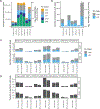Oncogenic Transformation Drives DNA Methylation Loss and Transcriptional Activation at Transposable Element Loci
- PMID: 37249603
- PMCID: PMC10527578
- DOI: 10.1158/0008-5472.CAN-22-3485
Oncogenic Transformation Drives DNA Methylation Loss and Transcriptional Activation at Transposable Element Loci
Abstract
Transposable elements (TE) are typically silenced by DNA methylation and repressive histone modifications in differentiated healthy human tissues. However, TE expression increases in a wide range of cancers and is correlated with global hypomethylation of cancer genomes. We assessed expression and DNA methylation of TEs in fibroblast cells that were serially transduced with hTERT, SV40, and HRASR24C to immortalize and then transform them, modeling the different steps of the tumorigenesis process. RNA sequencing and whole-genome bisulfite sequencing were performed at each stage of transformation. TE expression significantly increased as cells progressed through transformation, with the largest increase in expression after the final stage of transformation, consistent with data from human tumors. The upregulated TEs were dominated by endogenous retroviruses [long terminal repeats (LTR)]. Most differentially methylated regions (DMR) in all stages were hypomethylated, with the greatest hypomethylation in the final stage of transformation. A majority of the DMRs overlapped TEs from the RepeatMasker database, indicating that TEs are preferentially demethylated. Many hypomethylated TEs displayed a concordant increase in expression. Demethylation began during immortalization and continued into transformation, while upregulation of TE transcription occurred in transformation. Numerous LTR elements upregulated in the model were also identified in The Cancer Genome Atlas datasets of breast, colon, and prostate cancer. Overall, these findings indicate that TEs, specifically endogenous retroviruses, are demethylated and transcribed during transformation.
Significance: Analysis of epigenetic and transcriptional changes in a transformation model reveals that transposable element expression and methylation are dysregulated during oncogenic transformation.
©2023 American Association for Cancer Research.
Conflict of interest statement
Figures







References
Publication types
MeSH terms
Substances
Grants and funding
LinkOut - more resources
Full Text Sources
Medical
Molecular Biology Databases
Research Materials

